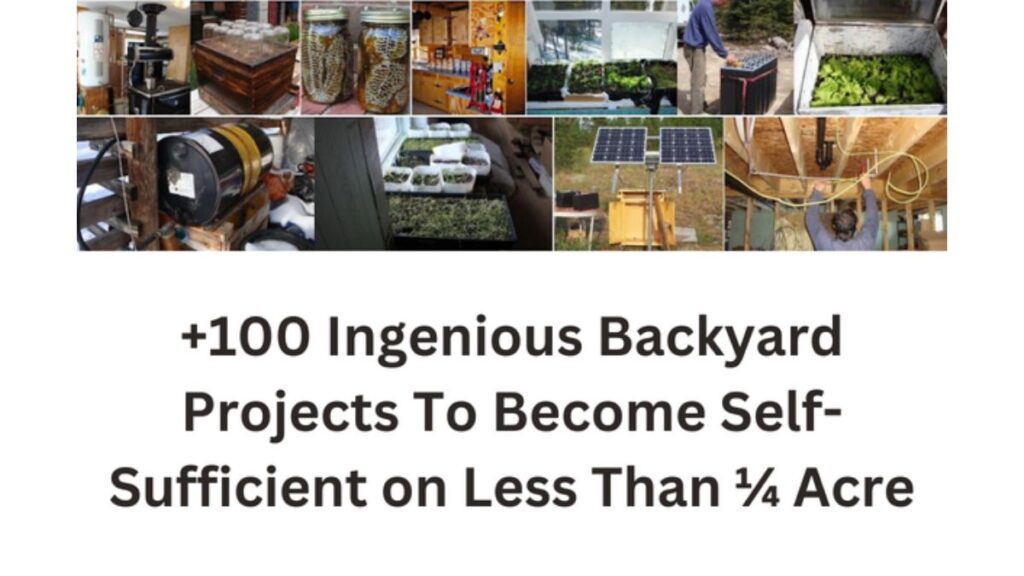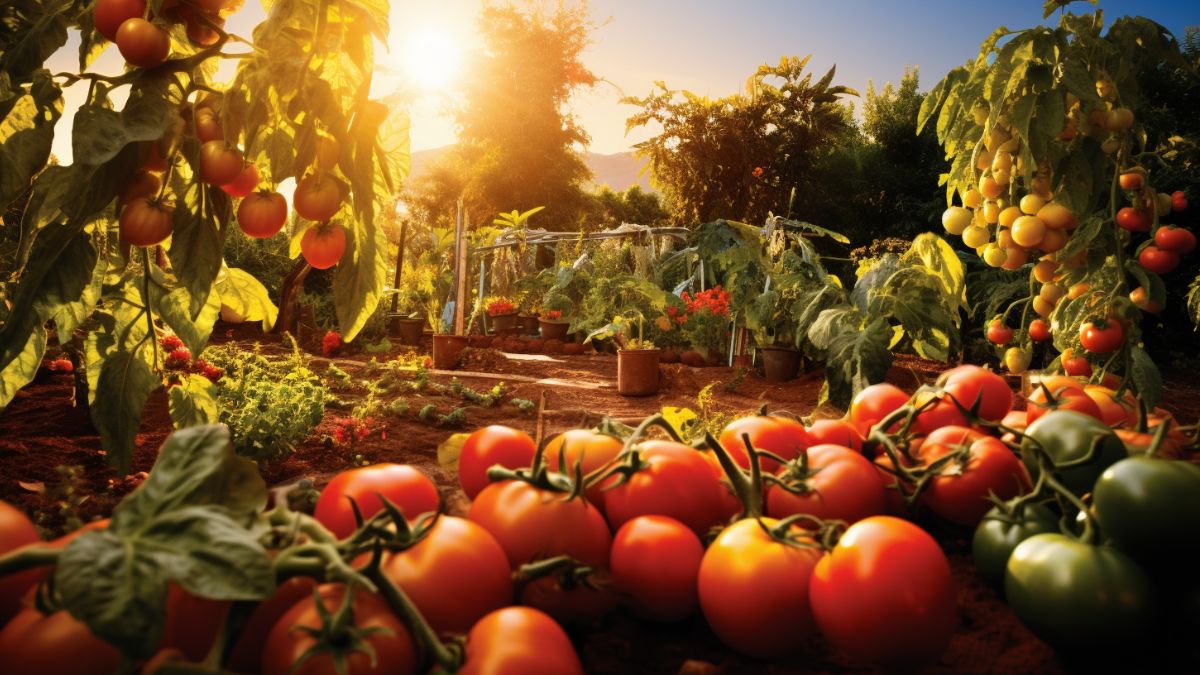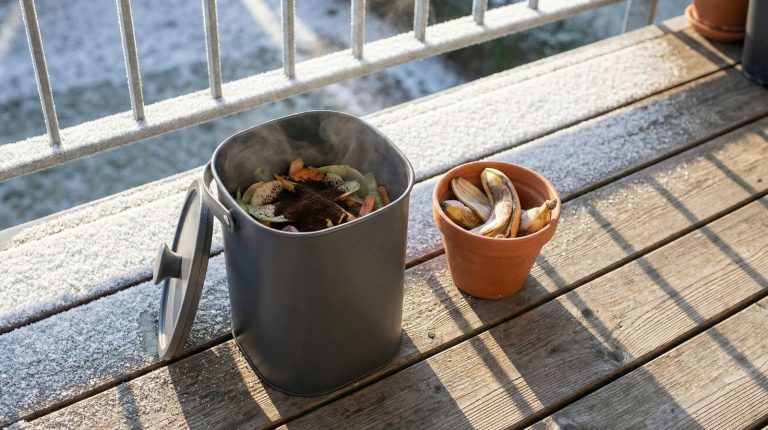Imagine a world where you are self-sufficient, growing your own survival foods with ease. No longer reliant on grocery stores or external sources, you have the power to sustain yourself and your loved ones.
In this article, we will unveil the secrets to achieving this level of self-sufficiency effortlessly. Discover the staple foods, nutritious options, and alternative sources of milk and meat that will ensure your survival. Join us on this journey towards belonging and empowerment.
Unlock the secrets to self-sufficiency and transform your home into a thriving homestead with The Self-Sufficient Backyard. Tap into our 40 years of experience and discover step-by-step projects and invaluable tips that will empower you to live off the grid and profit for a lifetime. Start your journey to self-sufficiency today!
Key Takeaways
- Potatoes, onions, beans, and corn are staple foods that are versatile, nutrient-rich, and easy to grow and store.
- Leafy greens, herbs, peanuts, grains, and pumpkins are nutritious foods that provide essential vitamins, minerals, protein, and carbohydrates for long-term survival.
- Herbs like basil, oregano, and rosemary enhance the flavor of dishes and have medicinal benefits.
- Additional foods like nuts, garlic, root vegetables, and apples can be grown to promote self-sufficiency and a connection to nature.
Staple Foods for Survival
If you’re looking to stock up on staple foods for survival, there are a few key options you should consider.
Potatoes are a versatile and nutrient-rich choice that can be grown easily. Onions provide flavor and can be stored for long periods of time. Beans are an excellent source of protein and can be dried and stored for years. Corn is a high-yield crop that can be used for both food and animal feed.
Lastly, carrots are packed with vitamins and can be grown in various climates.
Potatoes
You should definitely consider growing potatoes as they’re versatile and essential survival foods. Here’s why:
- Potato Varieties: There are countless potato varieties to choose from, each with its own unique flavor and texture. Whether you prefer the creamy texture of Yukon Gold or the starchy goodness of Russet, there’s a potato variety to suit every taste.
- Potato Storage: Potatoes are incredibly easy to store, making them a perfect survival food. They can be stored in a cool, dark place for several months without spoiling. This means you can have a steady supply of nutritious potatoes even during times of scarcity.
- Potato Recipes: Potatoes can be cooked in a variety of ways, making them a versatile ingredient in any meal. From mashed potatoes to roasted potatoes and even potato soup, the possibilities are endless. Plus, potatoes are packed with essential nutrients like vitamin C, potassium, and fiber, making them a healthy choice for your survival pantry.
By growing potatoes, you can ensure a steady supply of food that isn’t only delicious but also nutritious and easy to store.
Onions
To ensure a well-rounded survival pantry, consider adding onions to your list of staple foods, as they can be easily grown and stored for extended periods. Onions not only add flavor to your dishes as a versatile seasoning, but they also offer numerous health benefits.
When it comes to onion storage, there are a few tips to keep in mind. First, it’s important to store onions in a cool, dry, and well-ventilated area to prevent them from sprouting or rotting.
Additionally, different onion varieties have different storage requirements. For example, sweet onions tend to have a shorter shelf life compared to storage onions.
Beans
You should consider stocking up on at least three different types of beans for your survival pantry. Beans aren’t only nutritious and versatile, but they’re also easy to grow, making them an excellent addition to any self-sufficiency plan.
Here are three reasons why beans should be a priority in your survival garden:
- Growing techniques: Beans thrive in a variety of climates and soil conditions. You can sow them directly into the ground or start them indoors and transplant them later. They require minimal care and can be grown in small spaces, making them perfect for urban gardens.
- Harvesting methods: Beans are typically ready for harvest within 60-90 days. You can pick them when the pods are full and crisp. Harvesting regularly encourages continuous production, ensuring a steady supply of beans throughout the growing season.
- Cooking recipes: Beans are incredibly versatile and can be used in a wide range of dishes. From soups and stews to salads and dips, beans add a hearty and nutritious element to any meal. Experiment with different cooking methods and flavors to find your favorite bean recipes.
Corn
Consider adding corn to your survival garden, as it’s a versatile and nutrient-rich staple food that can be easily grown and harvested.
Growing corn has numerous benefits that contribute to self-sufficiency. Firstly, corn is packed with essential nutrients like fiber, vitamins, and minerals, making it a valuable addition to your diet. Secondly, corn is a versatile crop that can be used in various ways, such as grinding it into flour or using it as an ingredient in different dishes.
When it comes to choosing the best corn varieties for self-sufficiency, consider options like Dent corn, Flour corn, or Popcorn. These varieties are known for their high yields and adaptability to different growing conditions.
If you have limited space, you can still grow corn by using vertical gardening techniques or growing dwarf varieties specifically designed for small spaces. With these tips, you can enjoy the benefits of growing corn and enhance your self-sufficiency journey.
Related Post: Hydroponics Made Easy: Unlock the Secrets of Modern Gardening.
Carrots
If you want to diversify your survival garden, growing carrots is a great option because they’re easy to cultivate and provide essential nutrients. Here are three reasons why you should consider adding carrots to your garden:
- Health Benefits: Carrots are packed with vitamins and minerals that are crucial for your well-being. They’re rich in beta-carotene, which is converted into vitamin A in your body. Vitamin A is essential for good vision, immune function, and healthy skin.
- Growing Tips: Carrots thrive in loose, well-drained soil with plenty of sunlight. Start by preparing the soil by removing any rocks or clumps. Sow the seeds directly into the ground, about half an inch deep, and keep the soil consistently moist. Thin out the seedlings to allow proper spacing for the carrots to grow.
- Carrot Recipes: Once you harvest your carrots, there are countless delicious recipes you can try. From roasted carrots with honey glaze to carrot soup and even carrot cake, the options are endless. Carrots add a vibrant color and a sweet, earthy flavor to any dish.
By growing carrots in your survival garden, you not only ensure a steady supply of nutritious food but also open up a world of culinary possibilities.
Nutritious Foods for Long-Term Survival
If you’re looking for nutritious foods to ensure your long-term survival, consider incorporating leafy greens like lettuce, spinach, and kale into your diet. These vegetables are packed with essential vitamins and minerals that will keep you healthy and energized.
Don’t forget to grow herbs like basil, oregano, and rosemary for added flavor and medicinal benefits. Additionally, peanuts, grains, and pumpkins are excellent sources of protein, carbohydrates, and vitamins that can sustain you during challenging times.
Leafy Greens (lettuce, spinach, kale)
Growing leafy greens like lettuce, spinach, and kale will provide you with a continuous supply of nutritious food for long-term survival. These versatile and easy-to-grow plants are perfect for any aspiring self-sufficient individual.
Here are some essential growing techniques, harvesting tips, and nutrient requirements to ensure a successful harvest:
Growing Techniques
- Start seeds indoors or directly sow them in well-drained soil.
- Provide sufficient sunlight, at least 6-8 hours a day.
- Maintain a consistent moisture level, watering regularly but not excessively.
Harvesting Tips
- Harvest outer leaves first, allowing the inner ones to continue growing.
- Use a sharp knife or scissors to avoid damaging the plant.
- Avoid harvesting during the hottest part of the day to prevent wilting.
Nutrient Requirements
- Provide fertile soil with organic matter and a balanced fertilizer.
- Ensure proper spacing to allow air circulation and prevent disease.
- Monitor nutrient deficiencies and adjust fertilization accordingly.
Herbs (basil, oregano, rosemary)
To enhance the flavor of your dishes and boost your nutrition during long-term survival, consider adding herbs like basil, oregano, and rosemary to your homegrown garden. These herbs not only add a burst of flavor to your meals but also offer numerous health benefits.
When it comes to growing techniques, herbs are relatively easy to cultivate, making them a great addition to your self-sufficiency journey. Basil, for example, thrives in well-drained soil and requires regular watering. Oregano is a hardy herb that can tolerate various soil conditions and prefers full sun. Rosemary, on the other hand, requires well-draining soil and plenty of sunlight.
In terms of medicinal properties, basil has antibacterial and anti-inflammatory effects, while oregano is known for its antioxidant and antimicrobial properties. Rosemary has been linked to improved digestion and enhanced memory.
Additionally, these herbs have various culinary uses, adding depth and complexity to your dishes. So, why not start growing your herb garden today and enjoy the benefits of fresh, flavorful herbs right at your fingertips?
Peanuts
You should consider including a handful of peanuts in your long-term supplies of survival foods for their high nutritional value. Peanuts aren’t only delicious, but they also offer numerous health benefits that can help sustain you during challenging times.
Here are three reasons why peanuts should be a part of your plan of survival foods:
- Health Benefits: Peanuts are packed with essential nutrients such as protein, fiber, and healthy fats. They provide a good source of energy, promote heart health, and support brain function.
- Culinary Uses: Peanuts are incredibly versatile in the kitchen. They can be roasted, ground into peanut butter, or used in various recipes. Their rich and nutty flavor adds depth to both sweet and savory dishes.
- Growing Tips: Peanuts are relatively easy to grow, making them a great addition to your home garden. They thrive in warm climates and require well-drained soil. By growing your own peanuts, you can ensure a steady supply of it as one of your valuable survival foods.
Including peanuts in your supplies of survival foods not only provides nourishment but also allows you to enjoy their delicious taste and culinary versatility. With a bit of knowledge and effort, you can grow your own peanuts and have a sustainable source of food for the long term.
Grains
If you want to ensure long-term survival, having a variety of grains in your food supplies is essential.
Grains aren’t only a staple in baking, but they also provide numerous nutritional benefits. From wheat and rice to oats and barley, grains are rich in carbohydrates, fiber, vitamins, and minerals. They’re a great source of energy and can help keep you feeling full and satisfied.
Additionally, grains can be an excellent option for those following a gluten-free diet. With the rise in popularity of gluten-free options, you can now find a wide range of gluten-free grains like quinoa, amaranth, and millet.
Pumpkins
You can grow three pumpkins in your backyard and use them for nutritious meals during long-term survival. Pumpkins aren’t only delicious and versatile, but they also offer numerous health benefits. Here are three reasons why you should consider adding pumpkins to your self-sufficiency plan:
- Pumpkin seeds: These little powerhouses are packed with essential nutrients like magnesium, iron, and protein. They can be roasted for a tasty and nutritious snack or used in baking to add a delightful crunch.
- Pumpkin recipes: Pumpkins can be used in a variety of delicious recipes, from comforting soups and stews to mouthwatering pies and breads. Their sweet and earthy flavor adds depth to any dish.
- Pumpkin benefits: Pumpkins are rich in vitamins A, C, and E, which support immune function and promote healthy skin. They also contain fiber, which aids digestion and helps maintain a healthy weight.

Additional Foods for Self-Sufficiency
If you’re looking to expand your self-sufficiency, consider adding some additional foods to your survival garden.
Nuts like almonds, hazelnuts, and chestnuts are excellent sources of protein and healthy fats. Garlic not only adds flavor to your meals, but it also has numerous health benefits.
Root vegetables such as turnips, radishes, and beets are easy to grow and provide essential nutrients. And don’t forget about apples, which aren’t only delicious but also store well for long periods.
Nuts (almonds, hazelnuts, chestnuts)
Don’t forget to grow enough nuts, like almonds, hazelnuts, and chestnuts, for your self-sufficiency needs. These versatile and nutritious nuts are essential for your survival. Here’s why:
- Almonds farming: Almonds are packed with vitamins, minerals, and healthy fats. They’re a great source of protein and can be easily incorporated into your diet. Growing almond trees requires warm temperatures and well-drained soil. Once established, they’re relatively low-maintenance and can provide abundant harvests for years to come.
- Hazelnuts cultivation: Hazelnuts aren’t only delicious but also rich in antioxidants and healthy fats. Cultivating hazelnut trees requires a moderate climate and well-drained soil. They’re easy to grow and can be used in a variety of dishes or enjoyed as a snack.
- Chestnuts harvesting: Chestnuts are a hearty nut that can be stored for long periods, making them an excellent choice for self-sufficiency. They’re rich in fiber, vitamins, and minerals. Harvesting chestnuts involves collecting the ripe nuts that have fallen to the ground. They can be roasted, boiled, or used in various culinary creations.
Garlic
Growing garlic is a simple and rewarding way to enhance your self-sufficiency, providing you with a versatile ingredient for culinary creations. Garlic cultivation requires minimal effort and space, making it an ideal addition to your garden or even a small pot on your balcony.
Not only does garlic add flavor to your dishes, but it also offers numerous health benefits. It has been used for centuries for its medicinal properties, including boosting the immune system, reducing blood pressure, and fighting off infections. Incorporating garlic into your cooking can help improve your overall well-being.
From roasted garlic to garlic-infused oils and dressings, there are endless possibilities to explore. So, why not start growing your own garlic today and enjoy the delicious taste and health benefits it brings to your meals?
Root vegetables (turnips, radishes, beets)
You should try incorporating root vegetables like turnips, radishes, and beets into your diet because they’re packed with nutrients and can be easily grown in your own garden. These versatile vegetables offer a range of flavors and textures that can elevate your meals to new heights.
Here are some growing techniques, harvesting tips, and storage methods to help you get started:
Growing Techniques
- Plant root vegetables in well-draining soil with plenty of organic matter.
- Provide them with regular watering to ensure optimal growth.
- Thin out seedlings to give them enough space to develop.
Harvesting Tips
- Harvest turnips and radishes when they reach the desired size, usually within 30 to 60 days.
- For beets, wait until they’re about 2 inches in diameter.
- Gently pull them out of the ground, being careful not to damage the roots.
Storage Methods
- Remove the tops of the vegetables before storing.
- Store them in a cool, dark place or refrigerate for longer shelf life.
- Beet greens can be refrigerated separately and used in salads or sautés.
Incorporating these root vegetables into your diet not only adds variety to your meals but also promotes self-sufficiency and a sense of belonging to nature. So why not give them a try? Your taste buds and your garden will thank you.
Apples
If you’re looking to expand your self-sufficiency, incorporating apples into your diet can provide a versatile and nutritious addition to your meals. Apples come in a wide variety of flavors and textures, making them a delightful ingredient in both sweet and savory dishes.
When it comes to apple varieties, you have options like Gala, Granny Smith, Honeycrisp, and more, each with its unique taste and characteristics. To grow your own apple tree, ensure you provide it with proper care, including regular watering, pruning, and protecting it from pests.
In terms of apple preservation techniques, you can make applesauce, apple butter, or dehydrated apple slices to enjoy throughout the year.
Alternative Sources of Milk and Meat
Don’t overlook the often forgotten but valuable option of occasionally incorporating alternative sources of milk and meat into your diet. It’s not just about cows and chickens anymore. There are other options out there that aren’t only delicious but also sustainable and easy to make at home.
Here are three alternative sources to consider:
- Plant-based milk: Whether it’s almond, soy, or oat milk, these alternatives offer a dairy-free option that’s packed with nutrients. They’re also environmentally friendly, requiring fewer resources to produce compared to traditional dairy milk.
- Insects: Yes, you read that right! Insects like crickets and mealworms are gaining popularity as a sustainable and protein-rich meat alternative. They’re easy to raise at home and can be used in various recipes.
- Homemade dairy products: Instead of relying solely on store-bought dairy, try making your own yogurt, cheese, or butter. It’s a fun and rewarding process that allows you to control the ingredients and flavors.
Related Post: The Ultimate Guide to Companion Planting: Amplify Your Garden’s Success.
Frequently Asked Questions
What Are Some Staple Foods That Can Be Easily Grown for Survival?
Looking to be self-sufficient and grow your own survival foods? Well, there are some staple foods that can easily be grown to sustain you.
Alternative sources of protein like beans and quinoa are great options. Growing herbs not only adds flavor to your meals but also provides added nutrition.
And let’s not forget the benefits of vertical gardening, where you can maximize space and grow more food. With these techniques, you’ll be on your way to self-sufficiency in no time!
How Can I Ensure That My Long-Term Survival Diet Is Nutritionally Balanced?
To ensure your long-term survival diet is nutritionally balanced, it’s crucial to consider your nutritional needs during survival. Just like a well-oiled machine, your body requires a variety of nutrients to function optimally. Balancing your diet means incorporating a mix of proteins, carbohydrates, healthy fats, vitamins, and minerals.
Are There Any Other Foods Besides Staple Crops That I Should Consider Growing for Self-Sufficiency?
When it comes to self-sufficiency and ensuring a nutritionally balanced long-term survival diet, growing staple crops is just the beginning.
Consider incorporating alternative protein sources like backyard chickens into your self-sufficiency plan. They provide a sustainable source of eggs and meat. Additionally, vertical gardening can maximize your space and allow you to grow a variety of fruits, vegetables, and herbs.
What Are Some Alternative Sources of Milk and Meat That Can Be Easily Produced at Home?
Looking to be more self-sufficient in your food production? Well, when it comes to alternative sources of milk and meat, there are a few options that you can easily produce at home.
For milk, consider alternative sources like almond milk or coconut milk, which can be made right in your own kitchen. And if you’re looking for homemade cheese, try making it with goat’s milk or even soy milk.
As for DIY meat production, you can raise chickens or rabbits, which require less space and resources compared to larger livestock.
Are There Any Specific Considerations or Challenges When It Comes to Growing Alternative Sources of Milk and Meat?
When it comes to growing alternative sources of milk and meat, there are definitely some considerations and challenges to keep in mind.
One consideration is the availability of space and resources needed for raising animals or growing crops. Another challenge is ensuring the proper nutrition and care for these alternative sources.
It’s important to research and understand the specific needs and requirements of each alternative source before embarking on this endeavor.
Conclusion
Growing your own survival foods isn’t only a practical way to ensure self-sufficiency, but it can also be a rewarding and enjoyable experience. Just like a well-tended garden, with each seed planted and each harvest reaped, you’re cultivating your own resilience and ability to thrive in any situation. So, start planting those seeds of self-sufficiency today, and watch your own personal garden of survival bloom and flourish.
Unlock the secrets to self-sufficiency and transform your home into a thriving homestead with The Self-Sufficient Backyard. Tap into our 40 years of experience and discover step-by-step projects and invaluable tips that will empower you to live off the grid and profit for a lifetime. Start your journey to self-sufficiency today!




